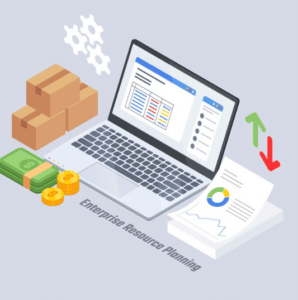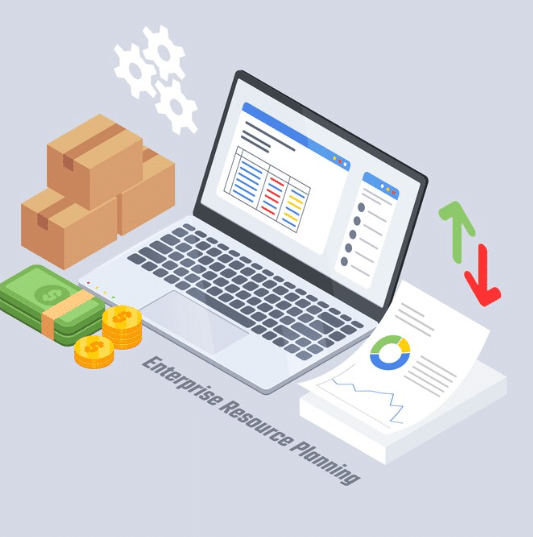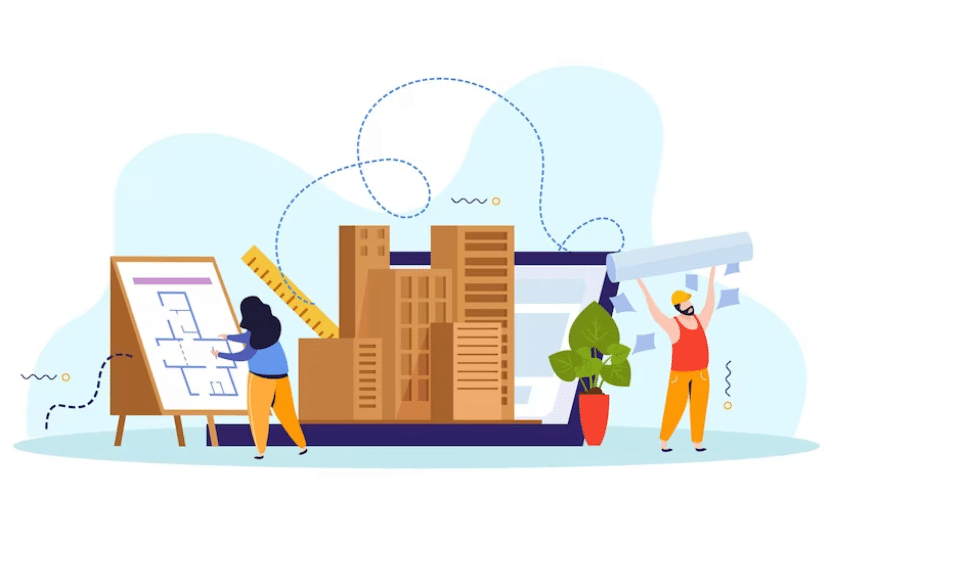
Blog
-

ERP Ecommerce
ERP Ecommerce-In today’s fast-paced and increasingly digital business landscape, companies are continually seeking ways to enhance their operations, improve customer experiences, and drive growth. One of the most powerful strategies that businesses have adopted to achieve these goals is the integration of Enterprise Resource Planning (ERP) and eCommerce systems. This synergy has become the cornerstone of success for countless organizations worldwide, and in this article, we’ll delve deep into the symbiotic relationship between ERP and eCommerce, exploring how this dynamic duo can help streamline processes, boost efficiency, andelevate your business to new he.
-

Construction ERP Software
Introduction
The construction industry, with its multifaceted projects and intricate processes, demands advanced solutions for effective project management. In recent years, the integration of technology has significantly impacted the construction landscape, giving rise to specialized software solutions like Construction ERP (Enterprise Resource Planning) Software. This article aims to comprehensively explore the nuances of Construction ERP Software, its role in reshaping project management, key features, benefits, and the overall impact on the construction sector.

Introduction
A. Definition and Overview
Construction ERP Software serves as a comprehensive platform designed to centralize and integrate diverse business processes within the construction domain. This section provides a detailed definition and an overview of the software’s functionalities, highlighting its significance in the contemporary construction environment.
B. Evolution of Construction ERP Software
The evolution of Construction ERP Software is essential to understanding its current capabilities and potential future developments. This subsection traces the historical development of Construction ERP Software, shedding light on its transformative journey.
II. Understanding Construction ERP Software
Construction ERP Software is a complex system with various modules catering to different aspects of project management. This section breaks down the software’s key components and elucidates their roles in enhancing project efficiency.
1. Project Management Module
At the core of Construction ERP Software lies its robust project management module. This subsection delves into the intricacies of how the software facilitates planning, scheduling, and execution of construction projects, offering insights into its practical applications.
2. Financial Management Module
Financial considerations are paramount in construction projects. This module explores how Construction ERP Software contributes to budgeting, cost tracking, and financial reporting, ensuring transparency and accountability in financial operations.
3. Resource Management Module
Efficient resource management is a critical aspect of successful construction projects. This component examines how Construction ERP Software optimizes the allocation and utilization of resources, covering aspects such as labor, equipment, and materials.
4. Document Management Module
The construction industry involves extensive documentation. This module explores how Construction ERP Software simplifies document handling, version control, and collaboration among project stakeholders, reducing administrative burdens.
III. Key Features of Construction ERP Software
The effectiveness of Construction ERP Software is derived from its distinctive features. This section scrutinizes these features, elucidating how they contribute to the software’s overall capabilities and the benefits they offer to construction project stakeholders.
A. Centralized Database
A centralized database serves as the backbone of Construction ERP Software. This subsection explores the advantages of having a single source of truth for all project-related data, emphasizing data integrity, and accessibility.
B. Real-time Collaboration
Collaboration is crucial for project success. This feature explores how Construction ERP Software facilitates real-time communication and collaboration among project teams, whether on-site or off-site, fostering a cohesive working environment.
C. Automation and Integration
Automation and integration streamline processes and reduce manual efforts. This section discusses how Construction ERP Software automates repetitive tasks and integrates with other business systems, ensuring seamless data flow and minimizing the risk of errors.
IV. Benefits of Implementing Construction ERP Software
The adoption of Construction ERP Software yields a multitude of benefits for construction companies. This section systematically outlines these advantages, showcasing how the software positively impacts various facets of construction project management.
A. Increased Efficiency and Productivity
Efficiency and productivity are paramount in the construction industry. This part highlights the ways in which Construction ERP Software enhances project efficiency and overall productivity by minimizing delays and optimizing workflows.
B. Cost Savings and Budget Control
Controlling costs is an ongoing challenge in construction projects. This subsection explores how Construction ERP Software aids in cost savings, budget control, and accurate financial forecasting, contributing to the overall financial health of construction projects.
C. Enhanced Decision-making
Informed decision-making is critical for project success. This segment discusses how Construction ERP Software provides real-time insights and analytics, empowering stakeholders to make data-driven decisions and respond promptly to changing project dynamics.
V. Case Studies: Successful Implementations
Real-world examples provide tangible evidence of the effectiveness of Construction ERP Software. This section presents case studies of construction companies that have successfully implemented the software, showcasing the transformative impact on their projects.
A. Case Study 1: Streamlining Mega Infrastructure Projects
Explore how a construction giant streamlined its mega infrastructure projects using Construction ERP Software, leading to improved project timelines, cost savings, and enhanced stakeholder collaboration.
B. Case Study 2: Small-Medium Enterprise (SME) Success Story
Delve into the success story of a small to medium-sized construction enterprise that leveraged Construction ERP Software to compete with larger counterparts, achieving remarkable efficiency gains and business growth.
VI. Challenges in Implementing Construction ERP Software
While the benefits are substantial, implementing Construction ERP Software comes with its set of challenges. This section identifies common hurdles faced during implementation and provides insights into overcoming these challenges.
A. Integration Challenges with Existing Systems
Explore the complexities associated with integrating Construction ERP Software with existing systems and strategies to mitigate potential integration challenges.
B. User Resistance and Training Issues
Understand the dynamics of user resistance and training issues during the implementation phase and discover effective strategies to overcome these hurdles.
C. Customization and Scalability Concerns
Address concerns related to software customization and scalability to ensure that Construction ERP Software aligns with the unique needs and growth trajectory of construction companies.
VII. Future Trends in Construction ERP Software
The construction industry is evolving rapidly, and so is Construction ERP Software. This section explores emerging trends and innovations in Construction ERP Software that are poised to shape the future of project management in the construction sector.
A. Integration of Artificial Intelligence (AI) and Machine Learning (ML)
Examine how the integration of AI and ML in Construction ERP Software is revolutionizing predictive analytics, risk management, and decision-making processes in construction projects.
B. Internet of Things (IoT) in Construction ERP
Explore the role of IoT in Construction ERP Software, enabling real-time monitoring of construction sites, equipment, and materials, contributing to enhanced project control and efficiency.
C. Sustainability and Green Construction Practices
Discover how Construction ERP Software is aligning with the growing emphasis on sustainability, supporting green construction practices, and aiding in the measurement and monitoring of environmental impacts.
VIII. Selecting the Right Construction ERP Software
Choosing the right Construction ERP Software is a critical decision that can significantly impact project outcomes. This section provides guidance on key considerations and factors to weigh when selecting the most suitable software for specific project needs.
A. Identifying Project-specific Requirements
Understand the importance of identifying project-specific requirements to ensure that the selected Construction ERP Software aligns with the unique needs and objectives of the construction project.
B. Scalability and Future-Readiness
Evaluate the scalability and future-readiness of Construction ERP Software to ensure that it can adapt to the evolving needs and growth of the construction company over time.
C. User Interface and Accessibility
Considerations related to the user interface and accessibility are pivotal. This subsection discusses the importance of an intuitive interface and accessibility features to enhance user adoption and overall usability.
IX. Implementation Best Practices
Implementing Construction ERP Software is a complex process that requires careful planning and execution. This section provides a roadmap and best practices for a smooth and successful implementation process.
A. Comprehensive Training Programs
Develop comprehensive training programs to ensure that all users, from project managers to on-site workers, are well-versed in using Construction ERP Software effectively.
B. Continuous Support and Updates
Highlight the importance of continuous support and regular updates from software providers to address issues, introduce new features, and ensure the longevity of the software.
C. Data Migration Strategies
Discuss effective data migration strategies to transition smoothly from existing systems to Construction ERP Software, minimizing data loss and ensuring data integrity.
X. Conclusion
In conclusion, Construction ERP Software stands as a transformative force in the construction industry, reshaping traditional project management approaches and paving the way for enhanced efficiency, collaboration, and decision-making. Its multifaceted benefits, coupled with ongoing technological advancements, position Construction ERP Software as an indispensable tool for construction companies aiming for sustainable growth and project success. As the construction industry continues its journey of digital transformation, Construction ERP Software will play a pivotal role in defining the future landscape of construction project manager.
-

MRP Software
In today’s ever-evolving business landscape, the path to staying competitive isn’t merely paved with hard work; it’s illuminated by the brilliance of working smarter. This profound realization has catalyzed the widespread adoption of ERP (Enterprise Resource Planning) Programs, which now stand as the bedrock of efficiency and growth for organizations worldwide. Let’s embark on a journey through the domain of ERP Programs, where we will delve into their essence, advantages, various types, and the myriad opportunities they bring to the forefront. Manufacturing Resource Planning (MRP) software has emerged as a pivotal tool for companies looking to optimize their production processes, reduce costs, and enhance overall efficiency. This comprehensive article delves into the world of MRP software, exploring its history, components, benefits, challenges, and its role in shaping the future of manufacturing.
Introduction to MRP Software
A. Brief explanation of MRP (Material Requirements Planning) At its core, Material Requirements Planning (MRP) is a systematic approach to managing and planning a company’s resources, particularly materials and inventory. It ensures that an organization has the right materials at the right time to meet production demands while minimizing excess stock. B. What is MRP Software and its role in modern business MRP Software takes the principles of MRP and brings them into the digital age. It’s a sophisticated tool that helps businesses plan, organize, and manage their materials, production schedules, and resources efficiently. MRP Software acts as the conductor of a well-orchestrated symphony, ensuring that materials flow seamlessly through the supply chain, optimizing inventory levels, and keeping production on track. In today’s complex business landscape, MRP Software is a game-changer, providing a competitive edge by delivering real-time insights and control over inventory and production processes.II. Key Features and Capabilities of MRP Software
A. Overview of MRP Software functionalities MRP Software is a multifaceted solution that offers a range of functionalities. It manages inventory, tracks materials, and schedules production, all while considering factors such as demand forecasting and lead times. With its comprehensive suite of tools, it provides a 360-degree view of your materials and production processes. B. How MRP Software streamlines inventory management One of the standout features of MRP Software is its ability to streamline inventory management. It optimizes inventory levels by calculating precisely when and how much of each material is needed. This reduces excess stock, minimizes carrying costs, and ensures that you have the right materials on hand to meet production demands. C. Forecasting and demand planning with MRP Software MRP Software is not just about reacting to current demands; it’s about forecasting future needs. By analyzing historical data and market trends, it can help you predict demand, ensuring that you’re always prepared to meet customer orders promptly.III. Benefits of Implementing MRP Software
A. Improved inventory control and accuracy With MRP Software, inventory becomes a well-oiled machine. It eliminates the guesswork and human error associated with manual inventory management, resulting in precise control and accuracy. B. Cost savings and reduced wastage By optimizing inventory levels and minimizing excess stock, MRP Software leads to significant cost savings. It also reduces wastage by ensuring materials are used efficiently. C. Enhanced production planning and scheduling MRP Software enhances production planning and scheduling by aligning production with real-time demand. This results in smoother operations, reduced lead times, and faster order fulfillment. D. Real-time insights and reporting One of the most invaluable aspects of MRP Software is its ability to provide real-time insights and reporting. This enables businesses to make informed decisions, adapt to changing market conditions, and stay ahead of the competition.IV. Case Studies and Success Stories
A. Examples of businesses benefiting from MRP Software To illustrate the real impact of MRP Software, let’s delve into some success stories. We’ll explore how businesses across different industries harnessed the power of MRP Software to optimize their operations, reduce costs, and stay competitive. B. Challenges they faced and how MRP Software helped overcome them These businesses faced challenges such as overstocked inventories, production bottlenecks, and unreliable demand forecasting. We’ll examine how MRP Software was the solution that transformed these challenges into success stories. Stay tuned as we dive into these compelling narratives, showcasing the tangible results that MRP Software can deliver. In the upcoming segments, we’ll explore implementation best practices, customization, integration options, and provide answers to common questions about MRP Software, empowering you to embark on a journey towards business excellence.V. Implementation Best Practices
A. Assessing your organization’s readiness for MRP Software Before embarking on the MRP Software implementation journey, it’s essential to take stock of your organization’s readiness. Assess your current processes, data quality, and the commitment of your team. Ensure that your organization is prepared for the changes that MRP Software will bring. Identify key stakeholders who will play pivotal roles in the implementation and gather their insights to align the software with your business’s unique needs. B. Planning and preparing for MRP Software implementation A well-thought-out implementation plan is the backbone of success. Define clear objectives, timelines, and responsibilities. Detail every step of the implementation process, from data migration to user training. By meticulously planning and preparing, you minimize the chances of unexpected roadblocks and ensure a smoother transition. C. Training and onboarding strategies Training your team effectively is crucial to a successful MRP Software implementation. Start with comprehensive training programs that cover the fundamentals and gradually progress to more advanced features. Consider offering ongoing training to keep your staff up-to-date and confident in using the software. A well-trained team is more likely to embrace the changes and maximize the benefits of MRP Software. D. Monitoring and optimizing MRP Software The journey with MRP Software doesn’t end with implementation; it’s an ongoing process of monitoring and optimization. Continuously evaluate the software’s performance and gather feedback from users. Be proactive in addressing any issues that arise and seize opportunities for improvement. MRP Software is a dynamic tool that evolves with your business, so staying attuned to its potential for enhancement is key.VI. Customization and Integration
A. Tailoring MRP Software to specific business requirements One of the standout advantages of MRP Software is its flexibility. It’s not a one-size-fits-all solution; it’s a canvas waiting for your organization’s unique brushstrokes. Embrace customization to tailor MRP Software to your specific business requirements. Whether it’s custom reports, workflows, or data fields, MRP Software can adapt to your processes, aligning seamlessly with your operations. B. Integration options with other software and systems MRP Software’s integration capabilities are a game-changer in the modern business landscape. It can seamlessly integrate with other software and systems your business relies on, creating a cohesive digital ecosystem. Whether it’s syncing with your CRM, accounting software, or e-commerce platform, MRP Software ensures that your data flows seamlessly, fostering efficiency, and collaboration.The Evolution of MRP Software
Origins of MRP Systems
The roots of MRP software can be traced back to the mid-20th century when manufacturers first began using computer-based systems to manage their production and inventory needs. These early systems, known as Material Requirements Planning (MRP), primarily focused on calculating the materials and components needed for production.Emergence of MRP II
The concept of MRP evolved into MRP II (Manufacturing Resource Planning) in the 1980s. MRP II expanded the scope beyond material planning and included aspects like capacity planning, scheduling, and shop floor control. This development marked a significant shift towards more comprehensive manufacturing planning systems.Introduction of ERP Systems
As businesses sought more integration across their operations, MRP II gradually gave way to Enterprise Resource Planning (ERP) systems, which encompassed not only manufacturing but also other areas like finance, human resources, and customer relationship management. Nevertheless, MRP principles remained integral within ERP systems, ensuring the effective management of production resources.Key Components of MRP Software
Bill of Materials (BOM)
The Bill of Materials is a fundamental component in MRP software. It lists all the materials, components, and subassemblies required for the production of a finished product. MRP software uses the BOM to calculate material requirements based on production orders and demand forecasts.Inventory Management
Inventory management in MRP software involves tracking the levels of raw materials, work-in-progress, and finished goods. The system helps in maintaining optimal inventory levels to prevent overstocking or shortages, thereby reducing carrying costs.Master Production Schedule (MPS)
The Master Production Schedule outlines the production plan for a specific period. It considers customer orders, forecasts, and available resources to create a detailed production schedule. MRP software uses the MPS as a basis for generating material requirements.Capacity Planning
Capacity planning in MRP software ensures that production resources, including labor and equipment, are efficiently utilized. It prevents overloading or underutilization of resources by aligning production requirements with the available capacity.Shop Floor Control
Shop floor control functionality allows manufacturers to monitor and control the progress of production orders in real-time. It tracks work orders, machine utilization, and labor efficiency, providing insights into production performance.Advantages of MRP Software
Enhanced Production Efficiency
One of the primary benefits of MRP software is the improvement in production efficiency. By accurately calculating material requirements and scheduling production, businesses can minimize idle time, reduce waste, and increase throughput.Inventory Optimization
MRP software assists in maintaining the right level of inventory. This prevents overstocking, which ties up capital, and understocking, which can lead to production delays. The optimized inventory levels lead to cost savings.Improved Planning and Scheduling
With MRP software, manufacturers can create detailed production plans and schedules. This leads to better resource utilization and ensures that production orders are completed on time.Data Accuracy and Transparency
MRP software centralizes data, ensuring that everyone in the organization works with the same, up-to-date information. This reduces errors and provides transparency into production processes.Cost Reduction
By streamlining production and inventory management, MRP software reduces operational costs. It also minimizes costly disruptions in production due to material shortages or overages.Challenges in Implementing MRP Software
Data Accuracy and Integrity
Data accuracy is critical in MRP software. Inaccurate data input can lead to incorrect material requirements, production delays, and increased costs. Maintaining data integrity is a continual challenge.Training and Change Management
Implementing MRP software often requires employees to adapt to new processes and technologies. Adequate training and change management are essential to overcome resistance to these changes.Integration with Other Systems
Integrating MRP software with other systems, such as ERP or customer relationship management (CRM) software, can be complex. Data must flow seamlessly between these systems for accurate planning and execution.Scalability
As businesses grow, their production needs change. Adapting MRP software to meet evolving demands while maintaining system stability can be a challenging task.Maintenance and Updates
Regular maintenance and updates are necessary to keep MRP software efficient and secure. Balancing the need for updates with system stability is an ongoing challenge.The Future of MRP Software
Integration with IoT and Industry 4.0
The future of MRP software lies in its integration with the Internet of Things (IoT) and Industry 4.0. Sensors and data from the shop floor will feed directly into MRP systems, allowing for real-time adjustments and predictive maintenance.Artificial Intelligence and Machine Learning
The implementation of artificial intelligence (AI) and machine learning (ML) will enable MRP software to make more accurate forecasts, optimize production schedules, and automatically adapt to changing conditions.Cloud-Based MRP Solutions
Cloud-based MRP systems will become increasingly prevalent, offering flexibility, scalability, and accessibility. This allows businesses to access their MRP software from anywhere and efficiently collaborate across locations.Mobile Accessibility
The mobile integration of MRP software will allow users to access critical information and make decisions on the go, further enhancing efficiency and flexibility in manufacturing processes.Sustainability and Green Manufacturing
The focus on sustainability and green manufacturing will drive the development of MRP software that can help optimize resource use and minimize waste, aligning with global environmental goals.VII. Conclusion
In conclusion, the journey through the world of MRP Software has been nothing short of enlightening. We’ve explored its functionalities, benefits, and best practices for implementation, customization, and integration. MRP Software isn’t just a tool; it’s a catalyst for transformation. It empowers your organization to optimize operations, reduce costs, and stay competitive in a dynamic market. Manufacturing Resource Planning (MRP) software has evolved significantly from its early days, becoming a vital tool in optimizing production processes, reducing costs, and enhancing efficiency. Its role in modern manufacturing is pivotal, providing companies with the means to manage resources effectively and maintain a competitive edge. -

SC ERP
SC ERP-The construction industry, with its multifaceted projects and intricate processes, demands advanced solutions for effective project management. In recent years, the integration of technology has significantly impacted the construction landscape, giving rise to specialized software solutions like Construction ERP (Enterprise Resource Planning) Software. This article aims to comprehensively explore the nuances of Construction ERP Software, its role in reshaping project management, key features, benefits, and the overall impact on the construction sector.

A. Definition and Overview
Construction ERP Software serves as a comprehensive platform designed to centralize and integrate diverse business processes within the construction domain. This section provides a detailed definition and an overview of the software’s functionalities, highlighting its significance in the contemporary construction environment.
B. Evolution of Construction ERP Software
The evolution of Construction ERP Software is essential to understanding its current capabilities and potential future developments. This subsection traces the historical development of Construction ERP Software, shedding light on its transformative journey.
II. Understanding Construction ERP Software
Construction ERP Software is a complex system with various modules catering to different aspects of project management. This section breaks down the software’s key components and elucidates their roles in enhancing project efficiency.
1. Project Management Module
At the core of Construction ERP Software lies its robust project management module. This subsection delves into the intricacies of how the software facilitates planning, scheduling, and execution of construction projects, offering insights into its practical applications.
2. Financial Management Module
Financial considerations are paramount in construction projects. This module explores how Construction ERP Software contributes to budgeting, cost tracking, and financial reporting, ensuring transparency and accountability in financial operations.
3. Resource Management Module
Efficient resource management is a critical aspect of successful construction projects. This component examines how Construction ERP Software optimizes the allocation and utilization of resources, covering aspects such as labor, equipment, and materials.
4. Document Management Module
The construction industry involves extensive documentation. This module explores how Construction ERP Software simplifies document handling, version control, and collaboration among project stakeholders, reducing administrative burdens.
III. Key Features of Construction ERP Software
The effectiveness of Construction ERP Software is derived from its distinctive features. This section scrutinizes these features, elucidating how they contribute to the software’s overall capabilities and the benefits they offer to construction project stakeholders.
A. Centralized Database
A centralized database serves as the backbone of Construction ERP Software. This subsection explores the advantages of having a single source of truth for all project-related data, emphasizing data integrity, and accessibility.
B. Real-time Collaboration
Collaboration is crucial for project success. This feature explores how Construction ERP Software facilitates real-time communication and collaboration among project teams, whether on-site or off-site, fostering a cohesive working environment.
C. Automation and Integration
Automation and integration streamline processes and reduce manual efforts. This section discusses how Construction ERP Software automates repetitive tasks and integrates with other business systems, ensuring seamless data flow and minimizing the risk of errors.
IV. Benefits of Implementing Construction ERP Software
The adoption of Construction ERP Software yields a multitude of benefits for construction companies. This section systematically outlines these advantages, showcasing how the software positively impacts various facets of construction project management.
A. Increased Efficiency and Productivity
Efficiency and productivity are paramount in the construction industry. This part highlights the ways in which Construction ERP Software enhances project efficiency and overall productivity by minimizing delays and optimizing workflows.
B. Cost Savings and Budget Control
Controlling costs is an ongoing challenge in construction projects. This subsection explores how Construction ERP Software aids in cost savings, budget control, and accurate financial forecasting, contributing to the overall financial health of construction projects.
C. Enhanced Decision-making
Informed decision-making is critical for project success. This segment discusses how Construction ERP Software provides real-time insights and analytics, empowering stakeholders to make data-driven decisions and respond promptly to changing project dynamics.
V. Case Studies: Successful Implementations
Real-world examples provide tangible evidence of the effectiveness of Construction ERP Software. This section presents case studies of construction companies that have successfully implemented the software, showcasing the transformative impact on their projects.
A. Case Study 1: Streamlining Mega Infrastructure Projects
Explore how a construction giant streamlined its mega infrastructure projects using Construction ERP Software, leading to improved project timelines, cost savings, and enhanced stakeholder collaboration.
B. Case Study 2: Small-Medium Enterprise (SME) Success Story
Delve into the success story of a small to medium-sized construction enterprise that leveraged Construction ERP Software to compete with larger counterparts, achieving remarkable efficiency gains and business growth.
VI. Challenges in Implementing Construction ERP Software
While the benefits are substantial, implementing Construction ERP Software comes with its set of challenges. This section identifies common hurdles faced during implementation and provides insights into overcoming these challenges.
A. Integration Challenges with Existing Systems
Explore the complexities associated with integrating Construction ERP Software with existing systems and strategies to mitigate potential integration challenges.
B. User Resistance and Training Issues
Understand the dynamics of user resistance and training issues during the implementation phase and discover effective strategies to overcome these hurdles.
C. Customization and Scalability Concerns
Address concerns related to software customization and scalability to ensure that Construction ERP Software aligns with the unique needs and growth trajectory of construction companies.
VII. Future Trends in Construction ERP Software
The construction industry is evolving rapidly, and so is Construction ERP Software. This section explores emerging trends and innovations in Construction ERP Software that are poised to shape the future of project management in the construction sector.
A. Integration of Artificial Intelligence (AI) and Machine Learning (ML)
Examine how the integration of AI and ML in Construction ERP Software is revolutionizing predictive analytics, risk management, and decision-making processes in construction projects.
B. Internet of Things (IoT) in Construction ERP
Explore the role of IoT in Construction ERP Software, enabling real-time monitoring of construction sites, equipment, and materials, contributing to enhanced project control and efficiency.
C. Sustainability and Green Construction Practices
Discover how Construction ERP Software is aligning with the growing emphasis on sustainability, supporting green construction practices, and aiding in the measurement and monitoring of environmental impacts.
VIII. Selecting the Right Construction ERP Software
Choosing the right Construction ERP Software is a critical decision that can significantly impact project outcomes. This section provides guidance on key considerations and factors to weigh when selecting the most suitable software for specific project needs.
A. Identifying Project-specific Requirements
Understand the importance of identifying project-specific requirements to ensure that the selected Construction ERP Software aligns with the unique needs and objectives of the construction project.
B. Scalability and Future-Readiness
Evaluate the scalability and future-readiness of Construction ERP Software to ensure that it can adapt to the evolving needs and growth of the construction company over time.
C. User Interface and Accessibility
Considerations related to the user interface and accessibility are pivotal. This subsection discusses the importance of an intuitive interface and accessibility features to enhance user adoption and overall usability.
IX. Implementation Best Practices
Implementing Construction ERP Software is a complex process that requires careful planning and execution. This section provides a roadmap and best practices for a smooth and successful implementation process.
A. Comprehensive Training Programs
Develop comprehensive training programs to ensure that all users, from project managers to on-site workers, are well-versed in using Construction ERP Software effectively.
B. Continuous Support and Updates
Highlight the importance of continuous support and regular updates from software providers to address issues, introduce new features, and ensure the longevity of the software.
C. Data Migration Strategies
Discuss effective data migration strategies to transition smoothly from existing systems to Construction ERP Software, minimizing data loss and ensuring data integrity.
X.Conclusion
In conclusion, Construction ERP Software stands as a transformative force in the construction industry, reshaping traditional project management approaches and paving the way for enhanced efficiency, collaboration, and decision-making. Its multifaceted benefits, coupled with ongoing technological advancements, position Construction ERP Software as an indispensable tool for construction companies aiming for sustainable growth and project success.
-

Oracle Netsuite ERP
Oracle Netsuite ERP-In the dynamic landscape of Enterprise Resource Planning (ERP) solutions, Oracle NetSuite ERP stands out as a powerful and comprehensive platform designed to streamline business operations, enhance efficiency, and drive organizational success. This comprehensive article aims to provide an in-depth exploration of Oracle NetSuite ERP, covering its definition, historical evolution, key features, benefits, industry applications, implementation strategies, and future trends.

A. Definition and Overview
Oracle NetSuite ERP is a cloud-based, integrated business management suite that encompasses a wide range of applications, including financial management, customer relationship management (CRM), inventory management, and more. This section introduces the concept of Oracle NetSuite ERP, outlining its core functionalities and its role in providing organizations with a unified and scalable solution.
B. Evolution of Oracle NetSuite ERP
Understanding the historical evolution of Oracle NetSuite ERP is essential to comprehend its current capabilities. This subsection traces the journey of NetSuite ERP from its inception to its acquisition by Oracle, highlighting the milestones and technological advancements that have shaped its development.
Key Features of Oracle NetSuite ERP
Oracle NetSuite ERP is renowned for its feature-rich platform. This section delves into the key features that define the software and explores how these functionalities contribute to the effectiveness of business management.
1. Unified Business Management Suite
At the core of Oracle NetSuite ERP is its unified suite of applications. This subsection explores how the integration of financials, CRM, inventory, and other modules provides organizations with a holistic view of their business operations.
2. Financial Management
Efficient financial management is a strength of Oracle NetSuite ERP. Delve into how the software streamlines accounting processes, automates financial reporting, and provides real-time insights into an organization’s financial health.
3. Customer Relationship Management (CRM)
Customer relationship management is crucial for business success. Explore how Oracle NetSuite ERP integrates CRM functionalities to manage customer interactions, sales processes, and marketing efforts seamlessly.
4. Inventory and Supply Chain Management
For organizations involved in product-based operations, effective inventory and supply chain management are paramount. This part delves into how Oracle NetSuite ERP optimizes inventory control, order processing, and supply chain visibility.
Benefits of Oracle NetSuite ERP
The adoption of Oracle NetSuite ERP offers a myriad of benefits for organizations seeking to elevate their business operations. This section systematically outlines these advantages, showcasing how Oracle NetSuite ERP positively impacts various facets of business management.
A. Cloud-Based Accessibility
Being a cloud-based solution, Oracle NetSuite ERP offers unparalleled accessibility. Explore how this feature facilitates remote work, enhances collaboration, and provides organizations with the flexibility to scale their operations.
B. Real-Time Data Insights
Access to real-time data is a key advantage of Oracle NetSuite ERP. This subsection discusses how organizations benefit from accurate, up-to-date information for informed decision-making and strategic planning.
C. Scalability for Business Growth
Scalability is a crucial aspect of Oracle NetSuite ERP. Explore how the software accommodates the growth of businesses, ensuring that business management tools remain effective as organizations expand.
Industry Applications of Oracle NetSuite ERP
Oracle NetSuite ERP is versatile and finds applications across various industries. This section explores how the software caters to the unique business management needs of sectors such as manufacturing, retail, services, and more.
A. Manufacturing Industry
Discover how Oracle NetSuite ERP addresses the specific business management challenges faced by manufacturing companies, from production planning to quality control.
B. Retail Sector
In the retail sector, Oracle NetSuite ERP offers tailored solutions for inventory management, order processing, and customer relationship management. Delve into how retailers leverage these solutions to enhance customer experiences.
C. Professional Services
For professional services firms, efficient project management and resource allocation are critical. Explore how Oracle NetSuite ERP supports service-oriented businesses in maintaining operational efficiency.
V. Implementation Strategies for Oracle NetSuite ERP
Implementing Oracle NetSuite ERP requires careful planning and execution. This section outlines key strategies for a successful implementation, covering considerations such as data migration, user training, and customization.
A. Data Migration Best Practices
Effective data migration is crucial for a smooth transition to Oracle NetSuite ERP. Explore best practices for planning and executing data migration, ensuring accuracy and integrity throughout the process.
B. User Training and Change Management
User adoption is pivotal for the success of any ERP implementation. This part emphasizes the importance of comprehensive user training programs and effective change management strategies to facilitate a smooth transition for employees.
C. Customization for Business Specificity
Oracle NetSuite ERP offers customization options to align with specific business needs. This subsection delves into how organizations can tailor the software to suit their unique business management and operational requirements.
VI. Challenges in Oracle NetSuite ERP Implementation
While the benefits of Oracle NetSuite ERP are substantial, challenges may arise during implementation. This section identifies common challenges faced by organizations adopting the software and provides insights into overcoming these hurdles.
A. Integration Complexity with Existing Systems
Integrating Oracle NetSuite ERP with existing systems can pose challenges. This subsection discusses strategies for overcoming integration complexities and ensuring seamless data flow between Oracle NetSuite ERP and other business applications.
B. User Resistance and Training Issues
User resistance is a common challenge in software implementations. Explore strategies to address employee resistance and foster a positive attitude towards using Oracle NetSuite ERP.
C. Customization Complexity
While customization is a strength, it can also present challenges. This component delves into the complexities associated with customization and offers guidance on finding the right balance between out-of-the-box functionality and tailored solutions.
A. Global Manufacturing Enterprise: Streamlining Operations
Explore how a global manufacturing enterprise streamlined its business operations, improved supply chain visibility, and enhanced collaboration across international locations through the successful implementation of Oracle NetSuite ERP.
B. E-commerce Retailer: Optimizing Order Fulfillment
Delve into the case study of an e-commerce retailer that leveraged Oracle NetSuite ERP to optimize order fulfillment, enhance customer satisfaction, and achieve operational efficiency.
Future Trends in Oracle NetSuite ERP
The landscape of Oracle NetSuite ERP is continually evolving. This section explores emerging trends and innovations that are expected to shape the future of business management with Oracle NetSuite ERP.
A. Artificial Intelligence (AI) Integration
Examine how the integration of artificial intelligence in Oracle NetSuite ERP is enhancing automation, predictive analytics, and providing intelligent insights for more informed business decision-making.
B. Enhanced Mobile Accessibility
Discover the growing importance of mobile accessibility in business management software. Explore how Oracle NetSuite ERP is adapting to the trend of remote work and on-the-go business management.
C. Enhanced Cybersecurity Measures
In an era of increasing cyber threats, cybersecurity measures are paramount. This component discusses how Oracle NetSuite ERP is evolving to incorporate enhanced security features to protect business data.
Selecting the Right Oracle NetSuite ERP Partner
Choosing the right Oracle NetSuite ERP partner is crucial for organizations embarking on the implementation journey. This section provides guidance on key considerations and factors to weigh when selecting the most suitable partner.
A. Experience and Expertise
Evaluate the experience and expertise of potential Oracle NetSuite ERP partners to ensure they understand the unique business management needs of your organization.
B. Support and Training Offerings
Assess the support and training programs offered by Oracle NetSuite ERP partners to ensure a smooth implementation process and ongoing assistance for your organization.
C. Customization Capabilities and Flexibility
Consider the customization capabilities and flexibility offered by Oracle NetSuite ERP partners to tailor the system to align with the unique business management requirements of your organization.
Conclusion
In conclusion, Oracle NetSuite ERP stands as a pinnacle in the world of business management solutions, offering organizations a comprehensive platform to navigate the complexities of business operations and enhance overall efficiency. From its historical evolution to its current standing as part of Oracle’s suite of solutions, Oracle NetSuite ERP has consistently evolved to meet the changing needs of businesses across various industries.
-

Best HR Systems for Small Businesses
Best HR Systems for Small Businesses – Navigating the vibrant world of small business ownership is no easy feat. Balancing ambitious goals with limited resources requires shrewd decisions, especially when it comes to managing your most valuable asset: your employees. Fortunately, technology offers a solution: Human Resources (HR) systems. But with a plethora of options available, choosing the right fit for your unique needs can feel overwhelming. Let’s demystify the world of HR systems and empower you to select the perfect tool for propelling your small business forward.

Why HR Systems Matter for Small Businesses
Imagine juggling recruitment, performance reviews, payroll, and compliance, all while striving to maintain a thriving company culture. That’s the reality for many small businesses. HR systems streamline these processes, unlocking a myriad of benefits:
- Increased Efficiency: Automate repetitive tasks like onboarding, leave management, and payroll, freeing up your time for strategic initiatives.
- Improved Accuracy: Ditch spreadsheets and manual errors. HR systems ensure accurate data recording and reporting, boosting your decision-making confidence.
- Enhanced Compliance: Stay ahead of complex regulations with built-in compliance features for taxes, labor laws, and employee records.
- Empowered Employees: Self-service portals grant employees easy access to paystubs, benefits information, and performance feedback, promoting engagement and ownership.
- Cost Savings: Reduced paperwork, streamlined processes, and improved HR efficiency all contribute to bottom-line savings.
Navigating the HR System Landscape: On-Premises vs. Cloud-Based
Understanding the two main deployment options can guide your decision:
- On-premises HR systems: These reside on your own servers, offering greater control and customization. However, they require upfront investment, IT expertise for maintenance, and potential scalability limitations.
- Cloud-based HR systems: Hosted on remote servers, these offer easy accessibility, lower upfront costs, and automatic updates. However, customization options might be limited, and data security concerns need careful evaluation.
Choosing the Right Features for Your Needs
Each small business is unique, and your HR system should reflect that. Consider these key features when evaluating potential options:
- Recruitment and Onboarding: Streamline recruitment with applicant tracking systems and simplify onboarding through automated tasks and centralized document management.
- Performance Management: Conduct and track performance reviews, set goals, and provide effective feedback to nurture employee growth.
- Compensation and Benefits: Simplify payroll processing, manage taxes, and offer a variety of benefits to attract and retain top talent.
- Time and Attendance: Track employee hours accurately and automate overtime calculations for hassle-free payroll and compliance.
- Compliance: Ensure adherence to labor laws and regulations with built-in features for leave tracking, tax calculations, and reporting requirements.
Beyond Features: Factors to Consider
- Company Size and Needs: Opt for systems designed for companies of your size and industry, ensuring they scale with your growth.
- Budget: Compare pricing models (subscriptions, per-user fees) and weigh them against the value proposition and potential return on investment.
- Ease of Use: Prioritize systems with intuitive interfaces and readily available support to maximize user adoption and reduce training costs.
- Integrations: Choose a system that integrates seamlessly with existing tools you use, like accounting software or communication platforms.
- Security and Data Privacy: Evaluate the system’s security measures to ensure your sensitive employee data is protected.
Do Your Research and Compare Options
Read online reviews, leverage comparison websites, and schedule demos with various providers. Engage in open communication with your team to understand their needs and preferences.
Conclusion:
Investing in the right HR system can be a transformative decision for your small business. By understanding your needs, exploring your options, and carefully considering the features and functionalities offered, you can unlock a future of improved efficiency, empowered employees, and sustained growth. Remember, the perfect HR system is not just software; it’s a strategic partner that fuels your success.
Additional Tips:
- Involve key stakeholders in the selection process to ensure buy-in and adoption.
- Consider future growth potential when choosing a system.
- Leverage free trials or demos to get a hands-on experience.
- Negotiate pricing and contracts to secure the best possible deal.
- Partner with a reliable implementation consultant to ensure a smooth transition.
By following these steps and utilizing the information provided, you can confidently select the best HR system for your small business, empowering you to focus on what matters most: building a thriving, successful enterprise.